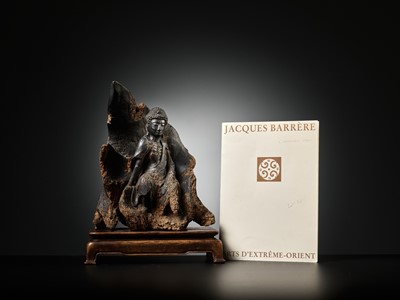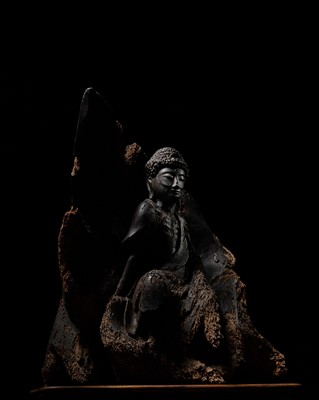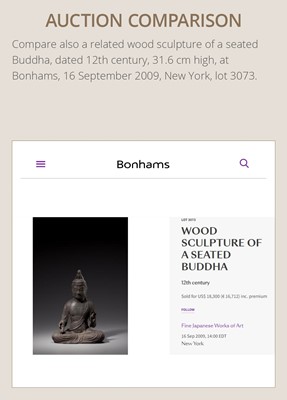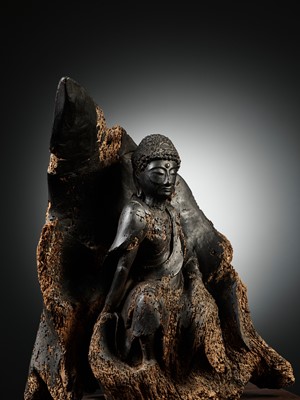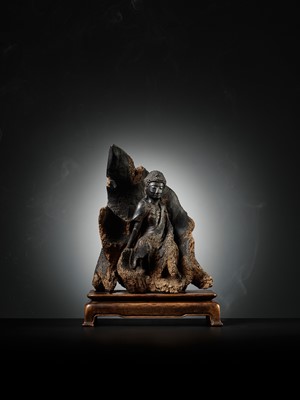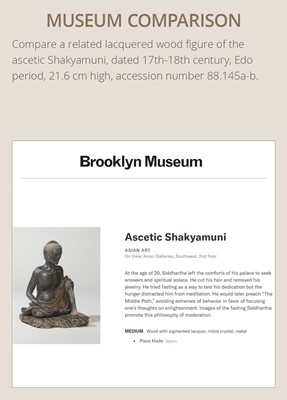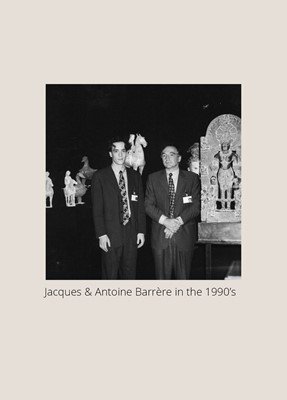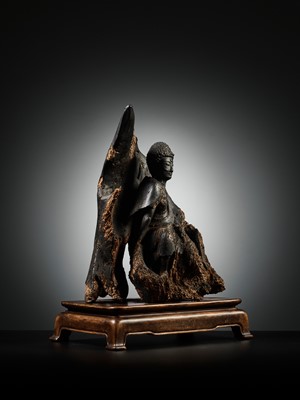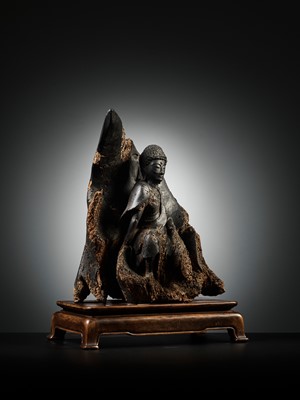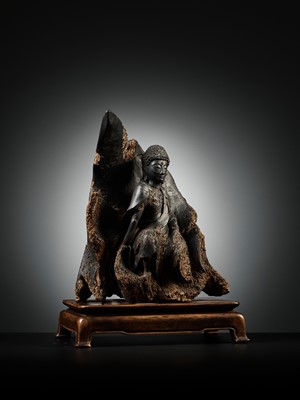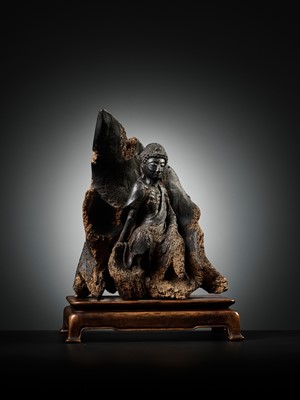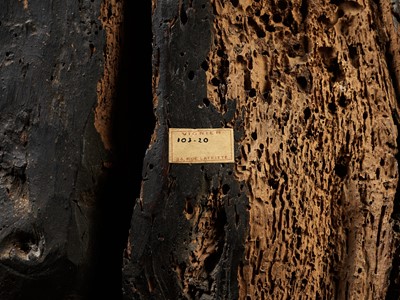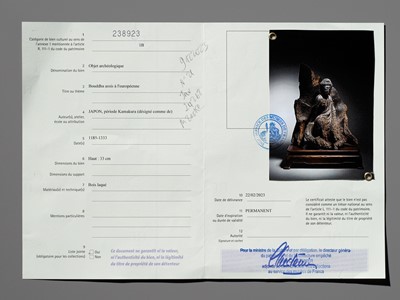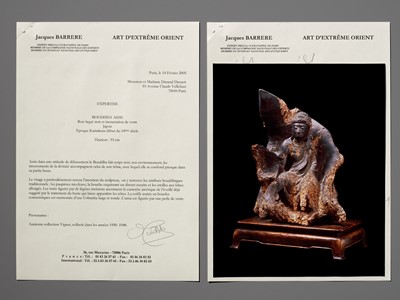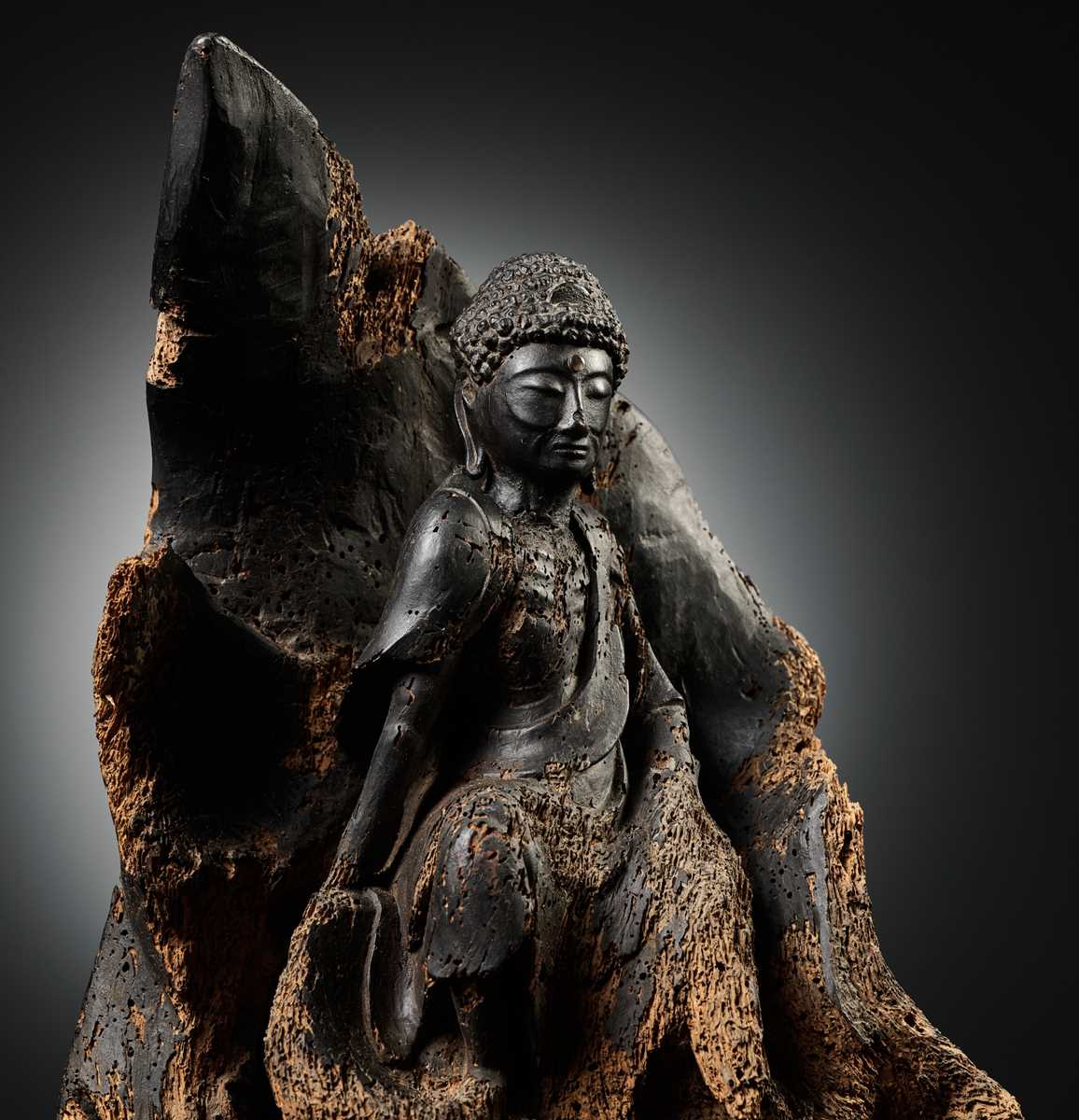16th Jun, 2023 11:00
Fine Japanese Art
43
AN EXTREMELY RARE AND IMPRESSIVE WOOD FIGURE OF THE ASCETIC SHAKYAMUNI BUDDHA, KAMAKURA PERIOD
Sold for €20,800
including Buyer's Premium
Japan, early 14th century, Kamakura period (1185-1333)
Exceptionally well carved, seated in a relaxed pose imbued with movement, the Buddha one with his grotto-like environment, his movements echoed by his naturalistic throne, with which he almost appears to merge.
The exquisitely serene face is finely carved with heavy-lidded eyes, gently arched brows, a glass-inlaid byakugo (urna), pronounced cheekbones, full lips, and long pendulous earlobes. His features subtly indicate his ascetic character, which is further suggested by the treatment of his slightly emaciated torso, partly obscured by the loose-fitting robe cascading in voluminous folds. His hair is arranged in tight curls over the high, domed ushnisha.
HEIGHT 32.4 cm (excl. stand) and 39.2 cm (incl. stand)
Condition: Superb condition, the wood with natural imperfections including signs of insect activity, at least some of which is inherent to the carving and only adding to the exceptional and breathtaking appearance of the figure. Wear, minor losses, light surface scratches, all as expected.
Provenance: Ex Paris Ancienne Collection Vignier, acquired during the 1930s. Jacques Barrère, Paris, February 2005. Liliane and Michel Durand-Dessert, Paris, acquired from the above. A signed expertise from Jacques Barrère, dated 14 February 2005, confirming the dating and provenance above, accompanies this lot. Jacques Barrère took over his mother’s flea market business, specializing in Far Eastern porcelain, cloisonné, and sculpture, in 1969. In the same year, he opened his gallery in Saint-Germain-des-Prés. The current Jacques Barrère gallery has been located on Rue Mazarine for over three decades and specializes in Chinese sculpture, archaeology, ceramics, and decorative arts, as well as Japanese sculpture and porcelain. In 2008, Jacques’ son Antoine Barrère has been running the gallery, bringing a fresh vision in a globalized art market. Objects once owned by Jacques Barrère have been included in major museums around the world, including the Musée Guimet and the Musée Cernuschi, the Shanghai Museum, and the Miho Museum. Liliane and Michel Durand-Dessert were luminous gallery owners who worked in Paris from 1975 to 2004, and were both informed and avant-garde collectors. They are significant not only because of the analytical and original approach the couple applied in each acquisition, but also because of their visionary take on exhibiting the most radical 20th-century art in their gallery, which was the subject of a 2004 retrospective organized by the Museum of Grenoble. According to Michel Durand-Dessert, who was inspired to open the couple’s first gallery by a visit to Documenta in 1968, “it is certain that a collection is a portrait, and that the objects we buy are those in which we sometimes recognize ourselves, sometimes we project ourselves. One way or another, acquiring them means adopting them, in every sense of the word.”
Mounted on an old wood stand.
The present sculpture vividly portrays Siddharta Gautama after renouncing his princely life, practicing extreme asceticism in the wilderness during his search for enlightenment. At the age of 29, Siddhartha left the comforts of his palace to seek answers and spiritual solace. He cut his hair and removed his jewelry. He tried fasting to test his dedication, but the hunger distracted him from meditation. During this time, he realized that such self-punishment was ultimately futile, and he eventually attained enlightenment through meditation and the Middle Path of balance and moderation. Images of the fasting Siddhartha promote this philosophy of moderation.
Depictions of the Buddha as an emaciated ascetic appeared in the ancient kingdom of Gandhara, and later also in Chinese art. It was in the Yuan dynasty that the modelling of Buddha in this manner became popular and a convention in Chinese art. However, according to Sherman Lee and Wai-kam Ho in Chinese Art Under the Mongols: The Yuan Dynasty (1279-1368), 1968, p. 124, “the prototype could be traced back at least to Kuan-hsiu's Sixteen Arhats of the Five Dynasties period, or Buddhist paintings of the ninth and tenth centuries showing hermits and the familiar figure of Vasu in Tun-huang and Central Asia.”
Museum comparison:
Compare a related lacquered wood figure of the ascetic Shakyamuni, dated 17th-18th century, Edo period, 21.6 cm high, accession number 88.145a-b.
Auction comparison:
Compare a Chinese bronze figure of the ascetic Buddha, dated Yuan to Ming dynasty, 17.2 cm high, at Sotheby’s, 20 September 2022, New York, lot 130 (sold for 50,400 USD). Compare also a related wood sculpture of a seated Buddha, dated 12th century, 31.6 cm high, at Bonhams, 16 September 2009, New York, lot 3073.
Japan, early 14th century, Kamakura period (1185-1333)
Exceptionally well carved, seated in a relaxed pose imbued with movement, the Buddha one with his grotto-like environment, his movements echoed by his naturalistic throne, with which he almost appears to merge.
The exquisitely serene face is finely carved with heavy-lidded eyes, gently arched brows, a glass-inlaid byakugo (urna), pronounced cheekbones, full lips, and long pendulous earlobes. His features subtly indicate his ascetic character, which is further suggested by the treatment of his slightly emaciated torso, partly obscured by the loose-fitting robe cascading in voluminous folds. His hair is arranged in tight curls over the high, domed ushnisha.
HEIGHT 32.4 cm (excl. stand) and 39.2 cm (incl. stand)
Condition: Superb condition, the wood with natural imperfections including signs of insect activity, at least some of which is inherent to the carving and only adding to the exceptional and breathtaking appearance of the figure. Wear, minor losses, light surface scratches, all as expected.
Provenance: Ex Paris Ancienne Collection Vignier, acquired during the 1930s. Jacques Barrère, Paris, February 2005. Liliane and Michel Durand-Dessert, Paris, acquired from the above. A signed expertise from Jacques Barrère, dated 14 February 2005, confirming the dating and provenance above, accompanies this lot. Jacques Barrère took over his mother’s flea market business, specializing in Far Eastern porcelain, cloisonné, and sculpture, in 1969. In the same year, he opened his gallery in Saint-Germain-des-Prés. The current Jacques Barrère gallery has been located on Rue Mazarine for over three decades and specializes in Chinese sculpture, archaeology, ceramics, and decorative arts, as well as Japanese sculpture and porcelain. In 2008, Jacques’ son Antoine Barrère has been running the gallery, bringing a fresh vision in a globalized art market. Objects once owned by Jacques Barrère have been included in major museums around the world, including the Musée Guimet and the Musée Cernuschi, the Shanghai Museum, and the Miho Museum. Liliane and Michel Durand-Dessert were luminous gallery owners who worked in Paris from 1975 to 2004, and were both informed and avant-garde collectors. They are significant not only because of the analytical and original approach the couple applied in each acquisition, but also because of their visionary take on exhibiting the most radical 20th-century art in their gallery, which was the subject of a 2004 retrospective organized by the Museum of Grenoble. According to Michel Durand-Dessert, who was inspired to open the couple’s first gallery by a visit to Documenta in 1968, “it is certain that a collection is a portrait, and that the objects we buy are those in which we sometimes recognize ourselves, sometimes we project ourselves. One way or another, acquiring them means adopting them, in every sense of the word.”
Mounted on an old wood stand.
The present sculpture vividly portrays Siddharta Gautama after renouncing his princely life, practicing extreme asceticism in the wilderness during his search for enlightenment. At the age of 29, Siddhartha left the comforts of his palace to seek answers and spiritual solace. He cut his hair and removed his jewelry. He tried fasting to test his dedication, but the hunger distracted him from meditation. During this time, he realized that such self-punishment was ultimately futile, and he eventually attained enlightenment through meditation and the Middle Path of balance and moderation. Images of the fasting Siddhartha promote this philosophy of moderation.
Depictions of the Buddha as an emaciated ascetic appeared in the ancient kingdom of Gandhara, and later also in Chinese art. It was in the Yuan dynasty that the modelling of Buddha in this manner became popular and a convention in Chinese art. However, according to Sherman Lee and Wai-kam Ho in Chinese Art Under the Mongols: The Yuan Dynasty (1279-1368), 1968, p. 124, “the prototype could be traced back at least to Kuan-hsiu's Sixteen Arhats of the Five Dynasties period, or Buddhist paintings of the ninth and tenth centuries showing hermits and the familiar figure of Vasu in Tun-huang and Central Asia.”
Museum comparison:
Compare a related lacquered wood figure of the ascetic Shakyamuni, dated 17th-18th century, Edo period, 21.6 cm high, accession number 88.145a-b.
Auction comparison:
Compare a Chinese bronze figure of the ascetic Buddha, dated Yuan to Ming dynasty, 17.2 cm high, at Sotheby’s, 20 September 2022, New York, lot 130 (sold for 50,400 USD). Compare also a related wood sculpture of a seated Buddha, dated 12th century, 31.6 cm high, at Bonhams, 16 September 2009, New York, lot 3073.
Zacke Live Online Bidding
Our online bidding platform makes it easier than ever to bid in our auctions! When you bid through our website, you can take advantage of our premium buyer's terms without incurring any additional online bidding surcharges.
To bid live online, you'll need to create an online account. Once your account is created and your identity is verified, you can register to bid in an auction up to 12 hours before the auction begins.
Intended Spend and Bid Limits
When you register to bid in an online auction, you will need to share your intended maximum spending budget for the auction. We will then review your intended spend and set a bid limit for you. Once you have pre-registered for a live online auction, you can see your intended spend and bid limit by going to 'Account Settings' and clicking on 'Live Bidding Registrations'.
Your bid limit will be the maximum amount you can bid during the auction. Your bid limit is for the hammer price and is not affected by the buyer’s premium and VAT. For example, if you have a bid limit of €1,000 and place two winning bids for €300 and €200, then you will only be able to bid €500 for the rest of the auction. If you try to place a bid that is higher than €500, you will not be able to do so.
Online Absentee and Telephone Bids
You can now leave absentee and telephone bids on our website!
Absentee Bidding
Once you've created an account and your identity is verified, you can leave your absentee bid directly on the lot page. We will contact you when your bids have been confirmed.
Telephone Bidding
Once you've created an account and your identity is verified, you can leave telephone bids online. We will contact you when your bids have been confirmed.
Classic Absentee and Telephone Bidding Form
You can still submit absentee and telephone bids by email or fax if you prefer. Simply fill out the Absentee Bidding/Telephone bidding form and return it to us by email at office@zacke.at or by fax at +43 (1) 532 04 52 20. You can download the PDF from our Upcoming Auctions page.
How-To Guides
How to Create Your Personal Zacke Account
How to Register to Bid on Zacke Live
How to Leave Absentee Bids Online
How to Leave Telephone Bids Online
中文版本的操作指南
创建新账号
注册Zacke Live在线直播竞拍(免平台费)
缺席投标和电话投标
Third-Party Bidding
We partner with best-in-class third-party partners to make it easy for you to bid online in the channel of your choice. Please note that if you bid with one of our third-party online partners, then there will be a live bidding surcharge on top of your final purchase price. You can find all of our fees here. Here's a full list of our third-party partners:
- 51 Bid Live
- EpaiLive
- ArtFoxLive
- Invaluable
- LiveAuctioneers
- the-saleroom
- lot-tissimo
- Drouot
Please note that we place different auctions on different platforms. For example, in general, we only place Chinese art auctions on 51 Bid Live.
Bidding in Person
You must register to bid in person and will be assigned a paddle at the auction. Please contact us at office@zacke.at or +43 (1) 532 04 52 for the latest local health and safety guidelines.

